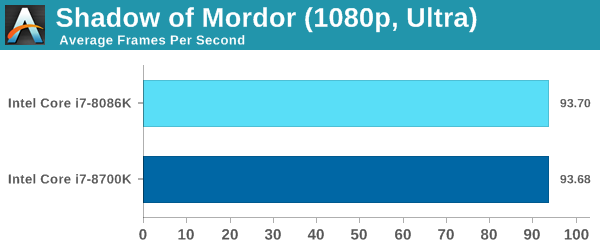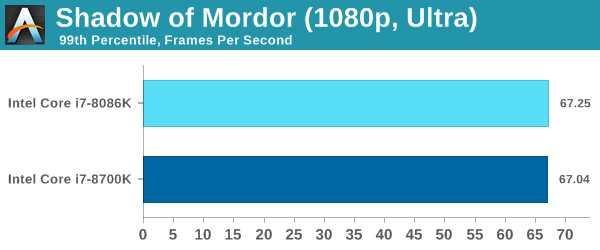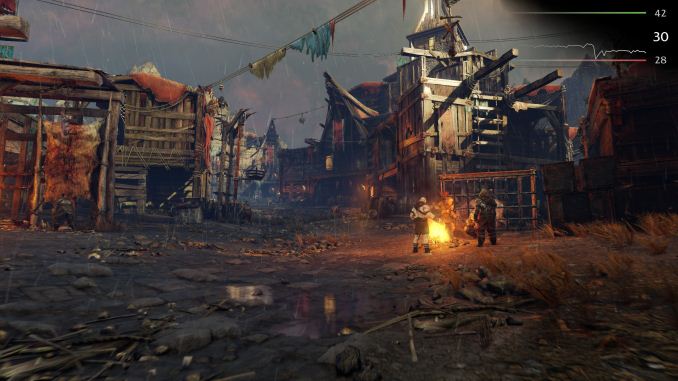The Intel Core i7-8086K Review
by Ian Cutress on June 11, 2018 8:00 AM EST- Posted in
- CPUs
- Intel
- Core i7
- Anniversary
- Coffee Lake
- i7-8086K
- 5 GHz
- 8086K
- 5.0 GHz
Shadow of Mordor
The next title in our testing is a battle of system performance with the open world action-adventure title, Middle Earth: Shadow of Mordor (SoM for short). Produced by Monolith and using the LithTech Jupiter EX engine and numerous detail add-ons, SoM goes for detail and complexity. The main story itself was written by the same writer as Red Dead Redemption, and it received Zero Punctuation’s Game of The Year in 2014.
A 2014 game is fairly old to be testing now, however SoM has a stable code and player base, and can still stress a PC down to the ones and zeroes. At the time, SoM was unique, offering a dynamic screen resolution setting allowing users to render at high resolutions that are then scaled down to the monitor. This form of natural oversampling was designed to let the user experience a truer vision of what the developers wanted, assuming you had the graphics hardware to power it but had a sub-4K monitor.
The title has an in-game benchmark, for which we run with an automated script implement the graphics settings, select the benchmark, and parse the frame-time output which is dumped on the drive. The graphics settings include standard options such as Graphical Quality, Lighting, Mesh, Motion Blur, Shadow Quality, Textures, Vegetation Range, Depth of Field, Transparency and Tessellation. There are standard presets as well.
We run the benchmark at 1080p and a native 4K, using our 4K monitors, at the Ultra preset. Results are averaged across four runs and we report the average frame rate, 99th percentile frame rate, and time under analysis.
All of our benchmark results can also be found in our benchmark engine, Bench.
ASRock RX 580 Performance















111 Comments
View All Comments
Hxx - Thursday, June 14, 2018 - link
who said binned chips? that would imply added costs. Did intel make some official statement? There is now way the 8086ks are binned chips. Intel clocked the 4.7ghz core to 5ghz on a 8700k. That's doable on any cooler you dont need a binned chip for that. Perhaps additional testing was done to make sure they're stable but there is no way intel cherry picked these chips.AutomaticTaco - Monday, June 11, 2018 - link
Okay. So people make purchases. So be it. If it's not better you can purchase something else. And others can make up their own minds.LemmingOverlord - Monday, June 11, 2018 - link
No real explanation why the 8086K underperforms the 8700K in multithreaded CPU tests, then. Considering they are rated the same at more than dual-core usage I can't really understand.Utter waste of money, that's for sure
Ryan Smith - Monday, June 11, 2018 - link
As noted in the testbed section, this wasn't run on our standard testbed since Ian didn't have it with him in Taiwan. Every motherboard is different, sometimes infuriatingly so.AsParallel - Monday, June 11, 2018 - link
Because ASRock and configuration. ASRock boards are a pain to dial in, and sometimes their firmware is an immovable object.artifex - Monday, June 11, 2018 - link
Waiting for the i7-80286K, so I can hit the turbo buttonTheinsanegamerN - Monday, June 18, 2018 - link
I'm waiting for the AMD 5x86 4700x that will slot into an intel motherboard.AsParallel - Monday, June 11, 2018 - link
Purchased one for me and a few to sit on the shelf for 10 years. Just in time for the 50th :)peevee - Friday, June 15, 2018 - link
Hopefully, by that time x64 will die.Jad77 - Monday, June 11, 2018 - link
I don't feel so bad about missing the contest now. How I managed to be so completely out of loop is baffling.